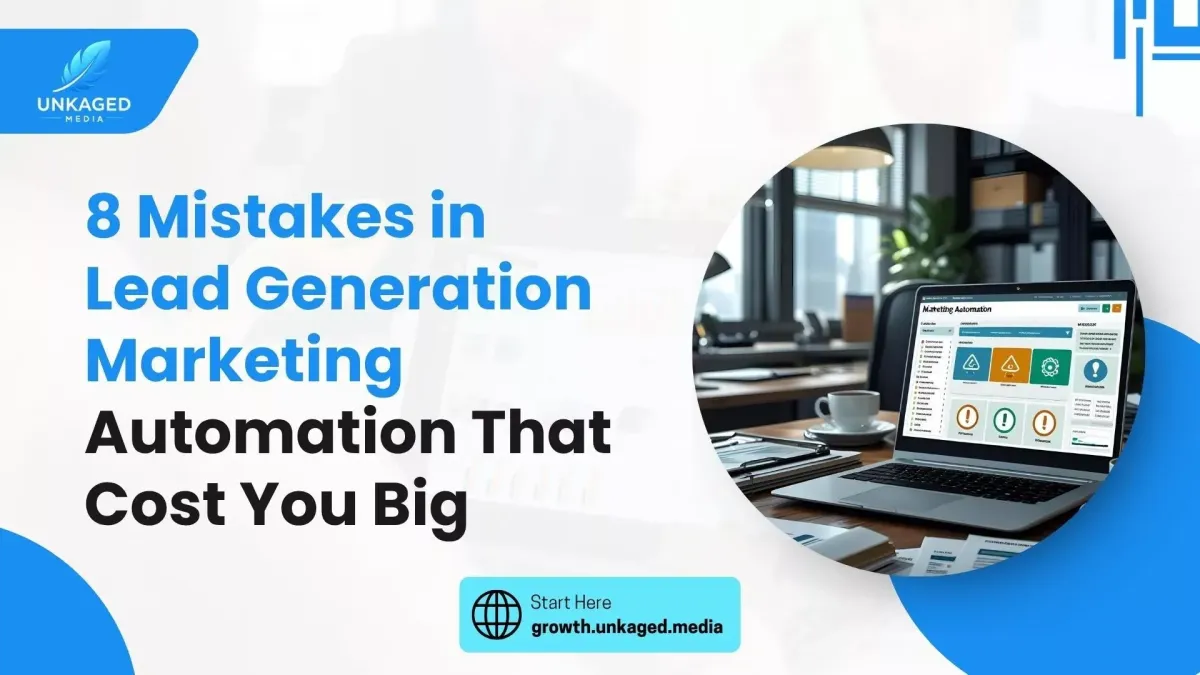
8 Mistakes in Lead Generation Marketing Automation That Cost You Big
Lead generation is tough. You work hard to attract the right people, but keeping them interested takes even more effort. That’s where lead generation marketing automation comes in. It helps you save time, follow up faster, and increase your chances of closing a sale. But automation can also go wrong, and when it does, it costs you money, leads, and your reputation. Many businesses set it up once and forget it. Others send the same message to everyone. Some skip testing or never look at the results.
These are small mistakes that lead to big problems. In this blog, we’ll break down the 8 most common automation mistakes. If you’re working with a marketing automation agency or building your marketing automation strategy, avoiding these mistakes can save your budget and get you better results.
1. Choosing Tools Without a Clear Goal
Most businesses jump into automation too fast. They pick the first tool they see or follow what a competitor uses. But tools won’t work unless you know why you need them. Before you set anything up, write down your goals.
Do you want more email signups? Better follow-ups? More booked calls? Without clear goals, you’ll waste time setting up the wrong features. You may also confuse your team or send the wrong messages to leads. Good automation starts with a plan.
Think about your customer journey. Where does automation fit in? What happens when someone fills out a form? What kind of message should they get next? A marketing automation implementation agency can help you map this out. They ensure your tools align with your goals. This helps you avoid wasted efforts and keeps your automation focused on results, not just tasks.
2. Sending Generic Messages to Every Lead
Many businesses use one message for everyone. It’s easy, but it feels cold and robotic. When you talk to leads this way, they lose interest fast. You can use basic segmentation to fix this. It helps you send the right message at the right time.
Segment by behavior: Track actions like link clicks or time on site to guide relevant follow-ups.
Segment by interest: Tag leads based on content they engage with to offer what they want.
Segment by lifecycle stage: New leads, warm leads, and sales-ready leads need very different messaging.
Segment by channel: Don’t send the same email to someone who prefers SMS or LinkedIn.
Segment by geography: Time zones and regional preferences matter in scheduling automated messages.
Even simple changes like using a name or mentioning a past action can make a big difference. It shows you’re paying attention, and people respond better when they feel seen.
3. Failing to Nurture Leads Properly
Not every lead is ready to buy right away. Some just want to learn. Others are still comparing options. If you try to sell too fast, they’ll walk away. That’s why lead nurturing matters. It means building trust over time. You can do this through emails, free guides, or friendly check-ins. Start with helpful info.
What you need to do is share tips, answer questions, and point them to useful content. Later, when they’re ready, they’ll be more likely to choose you. This works best when you plan your lead generation marketing automation strategy around it. Create simple drip campaigns that deliver value step by step.
Moreover, you can also use time delays and interest-based content to guide leads toward a sale without pressure. If you rush people, they tune out. But if you keep showing up with value, you stay top of mind. That’s how automation helps when it’s done right and not rushed.
4. Poor Integration With Your CRM
Your CRM and automation platform must work together. If they don’t, you’ll lose track of contacts, miss follow-ups, or send the wrong message. Let’s suppose a lead books a call, but your automation still sends them a “book now” email. It looks unprofessional and breaks trust.
To fix this, connect your CRM with your automation tools. Data should move both ways. When someone updates their info or takes an action, it should reflect everywhere. This keeps your team aligned and your leads on track.
Working with a marketing automation agency helps here. They understand how to sync platforms, clean up data, and keep systems talking to each other. You avoid duplicate contacts, outdated lists, and tech messes. When your tools work together, you work smarter. Leads move through the funnel without gaps, and your team can focus on closing, not fixing mistakes.
5. Not Testing or Optimizing Campaigns
Some businesses set up automation once and never look back. That’s a big mistake. What works today may not work next month. Trends change. People change. And if you don’t test or improve, your results will drop. Testing helps you find what your audience responds to. Start small. Try two subject lines.
Test two versions of your call to action. Change the timing of your emails. Even a simple word change can improve clicks and replies. Once you see what works, update your automation. Remove what doesn’t help. Keep improving your workflows. Don’t just guess; instead, use data.
If you’re working with a marketing automation agency, ask for monthly reviews. Look at open rates, click rates, and conversions. See where leads drop off. Small updates keep your flows fresh. Remember, automation is not a one-time setup. It’s a system you should test, measure, and improve often to get the best results.
6. Over-Automating the Customer Journey

Automation is helpful, but using it too much can backfire. Leads still want a human experience. If your entire journey is run by machines, it feels cold and lazy. You risk losing trust. There are moments when a personal touch matters more than speed. Here’s where you should step in:
High-value sales calls: Complex or costly products should have real conversations, not just automated follow-ups.
Customer service issues: Avoid bots during support interactions. Real help builds trust.
Proposal or quote delivery: Add personalization or one-on-one explanation, not just auto PDFs.
Contract signing: Send reminders, but follow up with personal confirmation.
Post-purchase feedback: Automated surveys are fine, but a real thank-you email goes further.
Don’t forget that people still buy from people. Use lead generation marketing automation to support the process, not replace it. When you find the right balance, you keep things smooth and personal. That’s how automation builds, not breaks, relationships.
7. Ignoring Lead Scoring Metrics
Lead scoring helps you tell hot leads from cold ones. Without it, you treat all leads the same, and that slows sales. Scoring means giving points to leads based on what they do. If someone opens your emails, visits your pricing page, or downloads a guide, they get a higher score. This helps your sales team know who to reach out to first.
Without scoring, your automation can push cold leads too fast or ignore the ones ready to buy. That’s wasted effort. You might send offers to people who aren’t interested or miss the ones who are.
To fix this, build a simple scoring system. Work with a marketing automation professional services team if needed. Keep it updated as your business grows. Lead scoring helps your marketing automation strategy work smarter. It tells you when to act and when to wait. And that leads to better conversions and happier customers.
8. Not Reviewing Analytics Regularly
Setting up automation isn’t the final step. You need to check your numbers often. If you skip this, problems will go unnoticed. Analytics show you what’s working and what’s not. You’ll see which emails get opened, which forms get filled, and which pages drive leads. This helps you make better decisions and fix gaps fast.
If open rates are low, try better subject lines. If leads drop off after step three, change that part of the flow. Small fixes based on real data can lead to big results. You don’t need to be a numbers expert. A lead generation marketing automation agency can help you track and understand reports. Make reviewing data a weekly habit. Automation without data is guessing. But when you check your reports, update your flows, and follow the numbers, you build a system that works over time.
Parting Words
Lead generation marketing automation work when it’s done right. But small mistakes can ruin good efforts. Focus on real goals, keep messages personal, and review your results often. These simple fixes lead to more leads, better trust, and more sales.
Need help setting up automation that works? Visit UnKAGEd Media and grow your leads the smart way.
Frequently Asked Questions
1. What is lead generation marketing automation?
It’s the use of software to automatically attract, nurture, and convert leads into customers using emails, forms, and workflows.
2. How can a marketing automation agency help?
They set up the right tools, build smart workflows, track results, and make sure your automation works without wasting time or money.
3. What are the benefits of using marketing automation?
It saves time, follows up with leads faster, improves conversions, and helps your sales team focus on the most ready-to-buy prospects.
4. How do I build a good marketing automation strategy?
Start with clear goals, segment your audience, map the customer journey, and use data to update your workflows regularly.
5. What tools are best for marketing automation?
Popular tools include HubSpot, ActiveCampaign, Mailchimp, and Zoho. The best one depends on your needs and budget.


